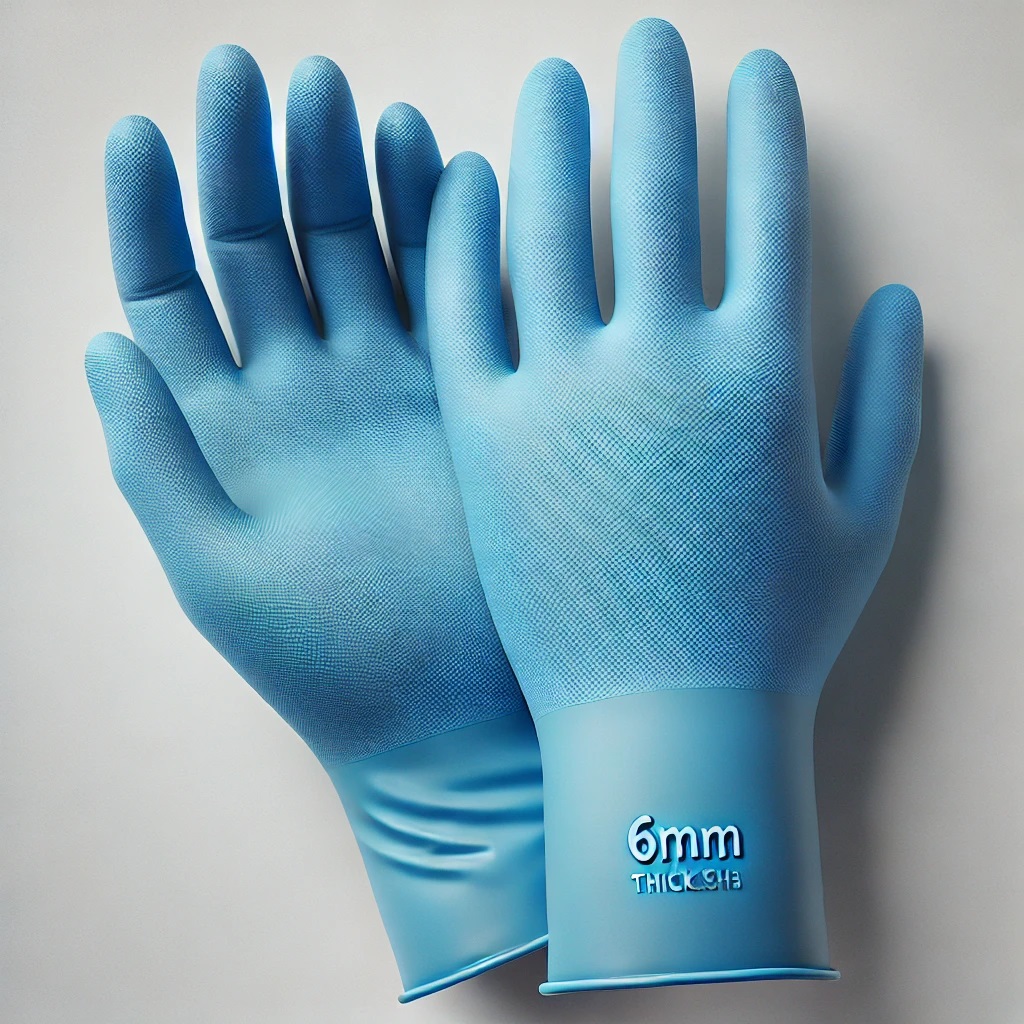
Introduction
Nitrile gloves have become an essential part of personal protective equipment (PPE) in various industries due to their superior resistance to chemicals, punctures, and abrasions. Specifically, 6mm nitrile gloves offer a balance of durability and flexibility, making them suitable for a wide range of workplace applications. This article delves into the standards for nitrile 6mm gloves in the workplace, covering safety regulations, material quality, and best practices for use to ensure maximum protection and efficiency.
What are Nitrile 6mm Gloves?
Definition and Importance
Nitrile 6mm gloves are made from synthetic rubber, providing a durable barrier against contaminants. Their thickness, measured at 6 millimeters, ensures a high level of protection while maintaining dexterity.
Key Features
- Chemical Resistance: Offers superior protection against a wide range of chemicals.
- Durability: High puncture and tear resistance.
- Allergen-Free: Unlike latex, nitrile gloves are hypoallergenic.
Safety Regulations for Nitrile Gloves
OSHA Standards
The Occupational Safety and Health Administration (OSHA) sets forth guidelines to ensure that gloves used in the workplace meet specific safety standards. OSHA requires that gloves provide adequate protection against the hazards they are intended to guard against, which includes chemical exposure and physical injuries.
FDA Regulations
The Food and Drug Administration (FDA) regulates gloves used in healthcare and food-related industries. These regulations ensure that gloves are safe for direct contact with food and medical equipment.
EN Standards
In Europe, EN standards (such as EN 374 for chemical protection) dictate the performance requirements for nitrile gloves. These standards are crucial for ensuring gloves provide adequate protection in various workplace environments.
Material Quality of Nitrile 6mm Gloves
Composition
Nitrile gloves are made from a synthetic rubber compound, which is a blend of acrylonitrile and butadiene. This composition provides excellent resistance to oils, fuels, and certain solvents.
Manufacturing Process
The manufacturing process involves dipping hand-shaped molds into nitrile compounds, followed by curing to form gloves. The quality control during manufacturing is essential to ensure the gloves meet the required standards for thickness, tensile strength, and puncture resistance.
Best Practices for Using Nitrile 6mm Gloves
Proper Sizing
Choosing the right size of gloves is critical. Gloves that are too tight can cause hand fatigue, while those that are too loose can compromise dexterity and protection.
Inspection Before Use
Always inspect gloves for tears, punctures, or defects before use. Even small damages can compromise the glove’s effectiveness.
Proper Disposal
After use, gloves should be disposed of according to workplace protocols to prevent contamination and environmental harm.
Applications of Nitrile 6mm Gloves in the Workplace
Healthcare
Nitrile gloves are widely used in healthcare settings due to their resistance to bloodborne pathogens and chemicals.
Laboratories
In laboratories, nitrile gloves protect against chemical spills and biological hazards, ensuring the safety of lab personnel.
Food Processing
The food industry uses nitrile gloves to prevent contamination and ensure hygiene standards are met.
Choosing the Right Nitrile Gloves
Thickness and Protection Level
The 6mm thickness provides a good balance between protection and dexterity, making it suitable for tasks that require both durability and sensitivity.
Powdered vs. Powder-Free
Powder-free gloves are preferred in most settings to avoid contamination and allergic reactions associated with powdered gloves.
Environmental Impact of Nitrile Gloves
Biodegradability
While nitrile gloves are not as biodegradable as natural latex gloves, advancements are being made to improve their environmental impact.
Recycling Programs
Some programs allow for the recycling of nitrile gloves, reducing their environmental footprint.
FAQs
What are the main benefits of using nitrile 6mm gloves?
Nitrile 6mm gloves offer superior chemical resistance, high durability, and are hypoallergenic, making them suitable for various applications.
How do I ensure I am using the correct size of nitrile gloves?
Measure your hand and compare it to the manufacturer’s sizing chart to find the correct size. Properly fitting gloves should be snug but not restrictive.
Are nitrile gloves recyclable?
Yes, some recycling programs accept nitrile gloves. Check local regulations and recycling options available in your area.
What is the difference between powdered and powder-free nitrile gloves?
Powdered gloves have a coating of cornstarch to make them easier to put on, while powder-free gloves do not, reducing the risk of contamination and allergic reactions.
How often should nitrile gloves be changed?
Nitrile gloves should be changed between tasks, when they become contaminated, or if they show any signs of damage.
Can nitrile gloves cause allergic reactions?
Nitrile gloves are generally hypoallergenic, but some individuals may still experience reactions to additives used in the manufacturing process.
Conclusion
Nitrile 6mm gloves are a vital component of PPE in various industries due to their durability, chemical resistance, and hypoallergenic properties. Adhering to safety regulations, understanding material quality, and following best practices for use can ensure maximum protection and efficiency. As the demand for reliable protective equipment grows, nitrile gloves continue to be a top choice for workplace safety.
